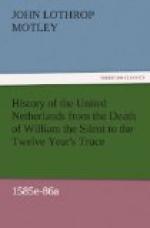And there was still another member of the house of Nassau who was already an honour to his illustrious race. Count William Lewis, hardly more than a boy in years, had already served many campaigns, and had been desperately wounded in the cause for which so much of the heroic blood of his race had been shed. Of the five Nassau brethren, his father Count John was the sole survivor, and as devoted as ever to the cause of Netherland liberty. The other four had already laid down their lives in its defence. And William Lewis, was worthy to be the nephew of William and Lewis, Henry and Adolphus, and the son of John. Not at all a beautiful or romantic hero in appearance, but an odd-looking little man, with a round bullet-head, close-clipped hair, a small, twinkling, sagacious eye, rugged, somewhat puffy features screwed whimsically awry, with several prominent warts dotting, without ornamenting, all that was visible of a face which was buried up to the ears in a furzy thicket of yellow-brown beard, the tough young stadholder of Friesland, in his iron corslet, and halting upon his maimed leg, had come forth with other notable personages to the Hague.
He wished to do honour heartily and freely to Queen Elizabeth and her representative. And Leicester was favourably impressed with his new acquaintance. “Here is another little fellow,” he said, “as little as may be, but one of the gravest and wisest young men that ever I spake withal; it is the Count Guilliam of Nassau. He governs Friesland; I would every Province had such another.”
Thus, upon the great question which presented itself upon the very threshold—the nature and extent of the authority to be exercised by Leicester—the most influential Netherlanders were in favour of a large and liberal interpretation of his powers. The envoys in England, the Nassau family Hohenlo, the prominent members of the States, such as the shrewd, plausible Menin, the “honest and painful” Falk, and the chancellor of Gelderland—“that very great, wise, old man Leoninus,” as Leicester called him,—were all desirous that he should assume an absolute governor-generalship over the whole country. This was a grave and a delicate matter, and needed to be severely scanned, without delay. But besides the natives, there were two Englishmen—together with ambassador Davison—who were his official advisers. Bartholomew Clerk, LL.D., and Sir Henry Killigrew had been appointed by the Queen to be members of the council of the United States, according to the provisions of the August treaty. The learned Bartholomew hardly seemed equal to his responsible position among those long-headed Dutch politicians. Philip Sidney—the only blemish in whose character was an intolerable tendency to puns—observed that “Doctor Clerk was of those clerks that are not always the wisest, and so my lord too late was finding him.” The Earl himself, who never undervalued the intellect of the Netherlanders whom




